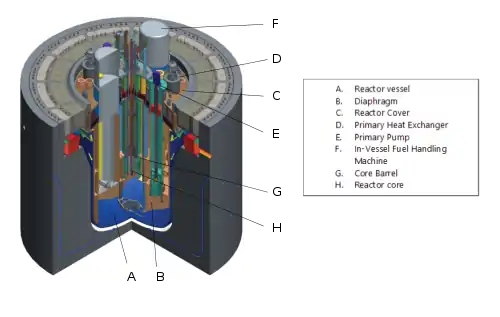MYRRHA
The MYRRHA (Multi-purpose hYbrid Research Reactor for High-tech Applications) is a "first of its kind" design project of a nuclear reactor coupled to a proton accelerator (a so-called Accelerator-driven system (ADS)). MYRRHA will be a lead-bismuth cooled fast reactor with two possible configurations: sub-critical or critical.

The project is managed by SCK CEN, the Belgian Centre for Nuclear Research. It will be built based on the experience gained from the first successful demonstration project: GUINEVERE.[1]
MYRRHA has an international recognition and has been listed in December 2010 by the European Commission as one of 50 projects to make Europe the leader in high-tech research in the next 20 years.[2]
MYRRHA is a research reactor aiming to demonstrate the feasibility of the ADS and the lead-cooled fast reactor concepts, with various applications from spent-fuel burning to material irradiation testing.[3]
MYRRHA is intended to be fully operational in 2036, with a first phase (100 MeV accelerator) ready in 2026.[4]
Special features
Accelerator
The ADS concept consists of coupling a subcritical reactor core with a proton accelerator. The neutrons missing from the sub-critical core in order to sustain the chain reaction originate from the spallation reaction of high energy proton beam with a heavy metal target. In order to operate a subcritical core with multiplication factor of k=0.95, a particle accelerator able to provide a maximum current of 4 mA beam of 600 MeV protons is needed. The option of a LINAC is currently preferred.
Due to the extreme rarity of such a stable accelerated proton beam, the MYRRHA project decided to include a fundamental physics experiment called ISOL@MYRRHA[5] using a fraction of the proton beam.
Spallation target
The spallation reaction requires a high Z material, chemical elements with a high atomic number (Z) of protons in the nucleus, as a target.
Fuel elements
Mixed oxide fuel (MOX) with an enrichment of 30% is planned to be used in the core. 15-15 Ti Austenitic stainless steel cladding allows for good corrosion resistance along with known behaviour in the nuclear industry.
Subcritical core
An important feature is the flexibility of MYRRHA, allowing two possible core configurations: subcritical or critical.
The subcritical core has an effective multiplication factor of 0.95: this is a unique feature in the world of nuclear reactors and will allow very innovative applications for MYRRHA such as burning of actinides or very long cycle operation.
Mechanical design
MYRRHA is a pool type lead-bismuth reactor; therefore the mechanical features will be a very heavy core, and atmospheric pressure operation of primary coolant loop. The coolant is very corrosive but operating temperature is quite low. An additional constraint is the opacity of lead-bismuth.
Towards validation
Recently, MYRRHA has entered a new phase in the validation process, with two new experiments aimed at providing insight into the thermo-hydraulic and resistance to earthquakes.[6]
The EU Commission has supported MYRRHA in the past and can earmark funds in 2016 for it.[7]
Schedule, budget and financing
The three-phase implementation plan starts with the construction of the particle accelerator's first phase (100 MeV) and PTF station (Proton Target Facility). This fully modular facility, called MINERVA, will be operational by 2027.
During this first period (2018–2026), the research and development needed to construct the full 600 MeV particle accelerator (Phase 2) and the reactor (Phase 3) will also be carried out. In addition, Phase 1 also includes pre-licensing. Phases 2 and 3 will be carried out simultaneously between 2027 and 2033. The reactor is scheduled to be commissioned by 2036. The MYRRHA research facility will be operational by 2027.
MYRRHA has a total budget of 1.6 billion euros. The Belgian government has financially supported the project since 2010. A budget of 100 million euros has already been allocated for the R&D period, for the design of the facility and for the implementation plan (2010–2017). In March 2018, the Federal authorities confirmed the allocation of 19.5 million euros this year in the construction of MYRRHA as well as its commitment in the project from 2019 onwards. On 7 September 2018, the Belgian federal government decided to invest 558 million euros in the MYRRHA project, i.e. 40% of the total infrastructure cost and the exploitation of the Phase 1. This will be used to complete phase 1 and prepare phases 2 and 3.[8]
In addition to this Belgian state support, MYRRHA will be funded by the creation of an international consortium of investors and by European Investment Bank (EIB) financing. A large number of partners have already expressed interest, such as France, Japan, Sweden, the US and Germany.
See also
References
- "Reactor-Accelerator Hybrid Achieves Successful Test Run". 12 January 2012.
- "Viser les déchets nucléaires avec un faisceau de protons – Result in Brief – CORDIS – European Commission".
- "IAEA website, " MYRRHA, An innovative and unique irradiation research facility"" (PDF).
- , planning
- "ISOL@MYRRHA home – SCK CEN". isolmyrrha.sckcen.be.
- "Deux installations test dédiées au futur réacteur nucléaire MYRRHA" [Two test facilities dedicated to future nuclear reactor MYRRHA]. L'Echo (in French): 6. 31 January 2014.
- "C_2014405DA.01000101.XML".
- "Belgian government approves funding for Myrrha". World nuclear news. 10 September 2018. Retrieved 8 October 2018.